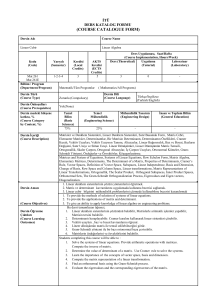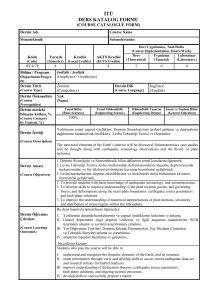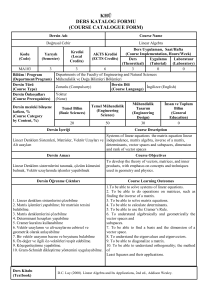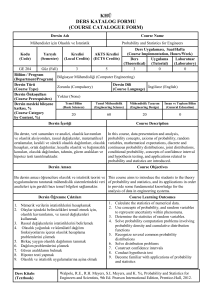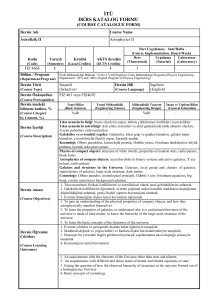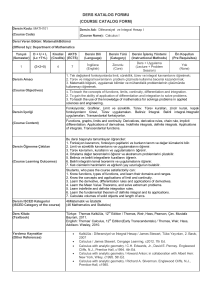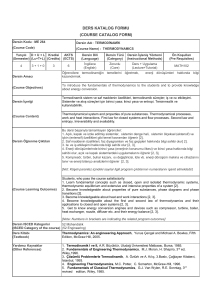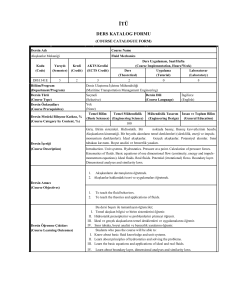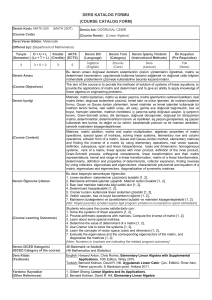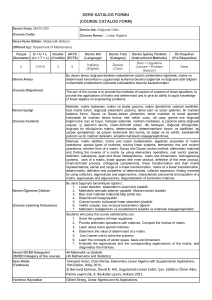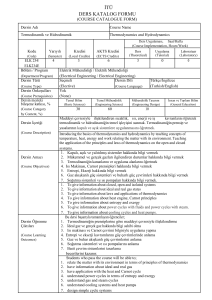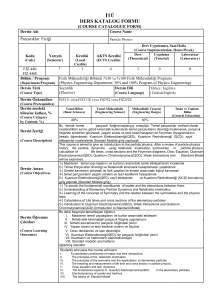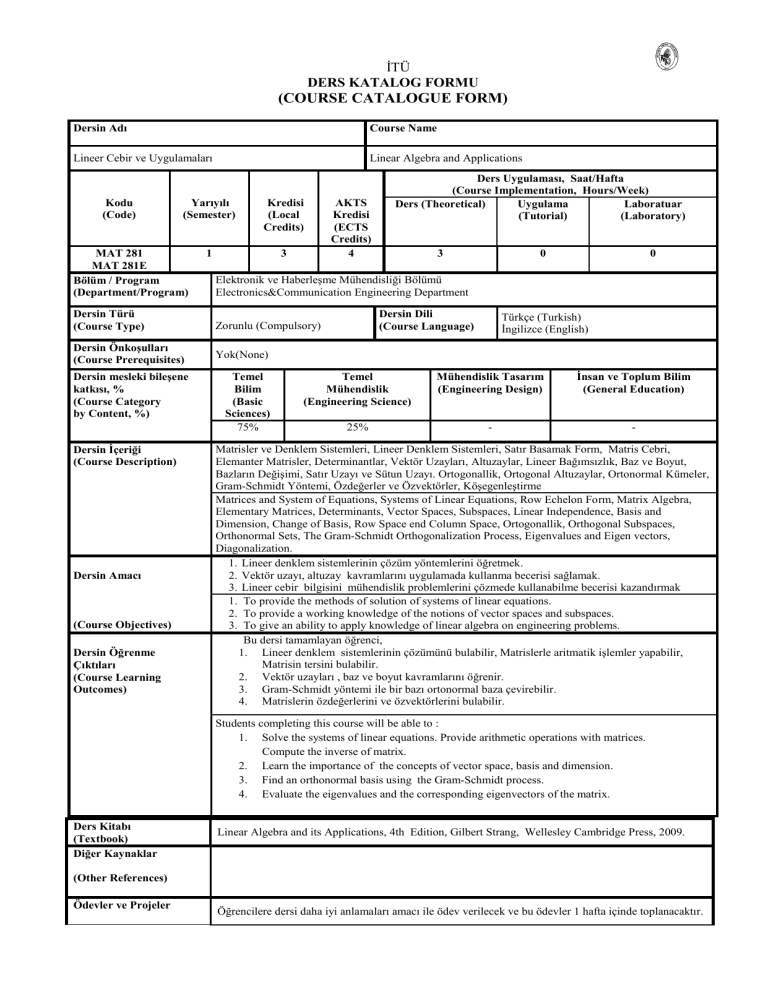
İTÜ
DERS KATALOG FORMU
(COURSE CATALOGUE FORM)
Dersin Adı
Course Name
Lineer Cebir ve Uygulamaları
Linear Algebra and Applications
Kodu
(Code)
Yarıyılı
(Semester)
MAT 281
MAT 281E
Bölüm / Program
(Department/Program)
Kredisi
(Local
Credits)
1
3
Zorunlu (Compulsory)
Dersin Önkoşulları
(Course Prerequisites)
Yok(None)
Dersin İçeriği
(Course Description)
Dersin Amacı
(Course Objectives)
Dersin Öğrenme
Çıktıları
(Course Learning
Outcomes)
3
0
0
Elektronik ve Haberleşme Mühendisliği Bölümü
Electronics&Communication Engineering Department
Dersin Türü
(Course Type)
Dersin mesleki bileşene
katkısı, %
(Course Category
by Content, %)
AKTS
Kredisi
(ECTS
Credits)
4
Ders Uygulaması, Saat/Hafta
(Course Implementation, Hours/Week)
Ders (Theoretical)
Uygulama
Laboratuar
(Tutorial)
(Laboratory)
Temel
Bilim
(Basic
Sciences)
75%
Dersin Dili
(Course Language)
Türkçe (Turkish)
İngilizce (English)
Temel
Mühendislik
(Engineering Science)
Mühendislik Tasarım
(Engineering Design)
İnsan ve Toplum Bilim
(General Education)
25%
-
-
Matrisler ve Denklem Sistemleri, Lineer Denklem Sistemleri, Satır Basamak Form, Matris Cebri,
Elemanter Matrisler, Determinantlar, Vektör Uzayları, Altuzaylar, Lineer Bağımsızlık, Baz ve Boyut,
Bazların Değişimi, Satır Uzayı ve Sütun Uzayı. Ortogonallik, Ortogonal Altuzaylar, Ortonormal Kümeler,
Gram-Schmidt Yöntemi, Özdeğerler ve Özvektörler, Köşegenleştirme
Matrices and System of Equations, Systems of Linear Equations, Row Echelon Form, Matrix Algebra,
Elementary Matrices, Determinants, Vector Spaces, Subspaces, Linear Independence, Basis and
Dimension, Change of Basis, Row Space end Column Space, Ortogonallik, Orthogonal Subspaces,
Orthonormal Sets, The Gram-Schmidt Orthogonalization Process, Eigenvalues and Eigen vectors,
Diagonalization.
1. Lineer denklem sistemlerinin çözüm yöntemlerini öğretmek.
2. Vektör uzayı, altuzay kavramlarını uygulamada kullanma becerisi sağlamak.
3. Lineer cebir bilgisini mühendislik problemlerini çözmede kullanabilme becerisi kazandırmak
1. To provide the methods of solution of systems of linear equations.
2. To provide a working knowledge of the notions of vector spaces and subspaces.
3. To give an ability to apply knowledge of linear algebra on engineering problems.
Bu dersi tamamlayan öğrenci,
1. Lineer denklem sistemlerinin çözümünü bulabilir, Matrislerle aritmatik işlemler yapabilir,
Matrisin tersini bulabilir.
2. Vektör uzayları , baz ve boyut kavramlarını öğrenir.
3. Gram-Schmidt yöntemi ile bir bazı ortonormal baza çevirebilir.
4. Matrislerin özdeğerlerini ve özvektörlerini bulabilir.
Students completing this course will be able to :
1. Solve the systems of linear equations. Provide arithmetic operations with matrices.
Compute the inverse of matrix.
2. Learn the importance of the concepts of vector space, basis and dimension.
3. Find an orthonormal basis using the Gram-Schmidt process.
4. Evaluate the eigenvalues and the corresponding eigenvectors of the matrix.
Ders Kitabı
(Textbook)
Diğer Kaynaklar
Linear Algebra and its Applications, 4th Edition, Gilbert Strang, Wellesley Cambridge Press, 2009.
(Other References)
Ödevler ve Projeler
Öğrencilere dersi daha iyi anlamaları amacı ile ödev verilecek ve bu ödevler 1 hafta içinde toplanacaktır.
(Homework & Projects
All homeworks are to be HANDED IN a week after they are assigned. Homeworks may be used as a
source for exams.
Laboratuar Uygulamaları
(Laboratory Work)
Bilgisayar Kullanımı
(Computer Use)
Diğer Uygulamalar
(Other Activities)
Başarı Değerlendirme
Sistemi
(Assessment Criteria)
Faaliyetler
(Activities)
Yıl İçi Sınavları
(Midterm Exams)
Kısa Sınavlar
(Quizzes)
Ödevler
(Homeworks)
Projeler
(Projects)
Dönem Ödevi
(Term Paper)
Laboratuar Uygulaması
(Laboratory Work)
Diğer Uygulamalar
(Other Activities)
Final Sınavı
(Final Exam)
Adedi
(Quantity)
2
Değerlendirmede Katkısı, %
(Effects on Grading, %)
50%
5
10%
1
40%
DERS PLANI
Hafta
1
2
3
4
5
6
7
8
9
10
11
12
13
14
Ders
Çıktısı
Konular
Lineer denklemlerin farklı yorumları
Eleme Yöntemi
LU ayrıştırması, matris tersi
Vektör uzayları, alt uzaylar
Bir matrisle ilişkili temel uzaylar
Lineer denklemlerin genel çözümü
Boyut, bazlar
Diklik
İzdüşüm, enküçük kareler
Gram-Schmidt yöntemi, QR ayrıştırması
Determinantlar
Özdeğerler ve özvektörler, köşegenleştirme
Simetrik matrisler, spektral teorem
Fark denklemleri, pozitif belirli matrisler
I
I
I
II
II
I-II
II
II-III
II-III
III
I-II
IV
IV
IV
COURSE PLAN
Weeks
1
2
3
4
5
Topics
Different ways of viewing a linear system of equations
The idea of elimination
LU decomposition, matrix inverse
Vector spaces, subspaces
The four fundamental subspaces
Course
Outcomes
I
I
I
II
II
6
7
8
9
10
11
12
13
14
Solution sets of linear systems
Dimension, bases
Orthogonality
Projections, least squares
Gram-Schmidt procedure, QR decomposition
Determinants
Eigenvalues and eigenvectors, diagonalization
Symmetric matrices, spectral theorem
Difference équations, positive definite matrices
I-II
II
II-III
II-III
III
I-II
IV
IV
IV
Dersin Mühendislik Programıyla İlişkisi
Katkı
Seviyesi
1 2 3
Programın mezuna kazandıracağı bilgi ve beceriler (programa ait çıktılar)
a
b
c
d
e
f
g
h
i
j
k
Matematik, fen bilimleri ve mühendislik bilgisini mühendislik problemlerini çözmede kullanabilme becerisi
Deney tasarlayıp yürütebilme, sonuçlarını analiz edip yorumlama ve modern araç, gereç ve teçhizatı
kullanabilme becerisi
Bir makinayı, parçasını veya prosesi, beklenen performansı, imalat özelliklerini ve ekonomikliği sağlayacak
şekilde seçme, geliştirme ve tasarlama becerisi
Çok disiplinli takımlarda çalışabilme ve/veya liderlik yapma becerisi
Mühendislik problemlerini tanımlama, formüle etme ve çözme becerisi
Mesleki ve etik sorumluluk anlayışına sahip olma
Türkçe ve İngilizce etkin yazılı ve sözlü iletişim kurma becerisi
Mühendisliğinin ulusal ve küresel boyutlardaki etkileri hakkında bilgi sahibi olma ve yorum yapabilme
becerisi
Hayat boyu (Sürekli) eğitimin önemini kavrama ve uygulayabilme becerisi
Mühendisliğinin güncel ve çağdaş konularına ilişkin bilgi sahibi olma
Mühendislik tasarım ve analizlerinde bilgisayar yazılımları gibi modern mühendislik yöntemlerini ve çağdaş
bilgi erişim olanaklarını kullanabilme becerisi
X
X
X
X
X
X
X
X
X
X
1: Az Katkı, 2. Kısmi Katkı, 3. Tam Katkı
Relationship between the Course and the Engineering Curriculum
Level of
Contribution
1
2
3
Program Outcomes
a
b
c
d
e
f
g
h
i
j
k
An ability to apply knowledge of mathematics, science, and engineering on engineering problems
An ability to design and conduct experiments, as well as to analyze and interpret data and use modern
tools and equipment.
An ability to select, develop and/or design a system, component, or process to meet desired performance,
manufacturing capabilities and economic requirements.
An ability to function on and/or develop leadership in multi-disciplinary teams.
An ability to identify, formulate, and solve engineering problems.
An understanding of professional and ethical responsibility
An ability for effective written and oral communication in Turkish and English.
An ability to understand and comment on the impact of engineering solutions in a national and global
context.
A recognition of the need for, and an ability to engage in life-long learning
A knowledge of contemporary issues in engineering
An ability to use the techniques, skills, and modern engineering tools , such as computer programs,
necessary for engineering design and analysis and use modern information systems
X
X
X
X
X
X
X
X
X
X
1: Little Contribution, 2. Partial Contribution, 3. Full Contribution
Düzenleyen (Prepared by)
Elektronik ve Haberleşme Müh. Bölümü
Dept. Of Electronics and Communications Eng.
Tarih (Date)
2014
İmza (Signature)

